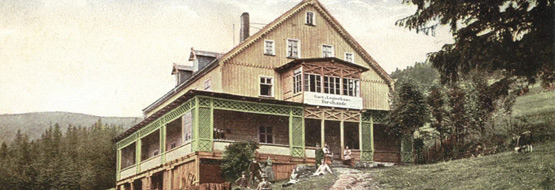Wersja kontrastowa: Alt + Z
Przejdź do treści strony: Alt + X
Przejdź do nawigacji strony: Alt + C
Mapa Witryny: Alt + V
Wyszukiwarka: Alt + B

Today Budniki is a mid-forest clearing situated on the northern slopes of Kowary Ridge (Kowarski Grzbiet). It lies at an altitude of 900 m.a.s.l. where Tobacco Path (Tabaczana Ścieżka) (the green tourist trail) crosses the path of the yellow trail, leading from Skalny Stół to Kowary. When you look at the trees and self-sown plants around, it is hard to believe that 50 years ago, you could see here houses vibrant with life. This mountain village was established during the Thirty Years' War (1618-1648). People were fleeing the war and hiding high in the forests of Giant Mountains. Since armed activities were continued for many years, refugees established temporary villages, and some of them turned into entire settlements. People living there were rearing cattle and making cheese. Some of them were woodcutters and other were familiar with poaching and smuggling. The latter began in the second half of 18th century when Prussia annexed Śląsk from Austria, designating a new border along the ridges of Sudetes. A large-scale smuggling developed at the beginning of 19th century. The name of the path leading through Budniki, the Tobacco Path, is a reminder of that time. It was snuff and tobacco that smugglers transported most frequently.
Budniki was not a big village. There were from 11 to 13 buildings. The evangelical school, existing at that time, rented one big classroom in one of the private houses. School was built later. It was rather peculiar situation in Giant Mountains since it served very few children, i.e. in 1894 the school was attended by four students: three girls and one boy. They gained knowledge under the supervision of a teacher Liebig. There was a small but well-maintained Alpine garden which served also educational purposes. In the summer, during holiday the school was used by tourists as an accommodation facility. Development of tourism became for inhabitants of Budniki an additional way of earning money. Two inns were established in the village. The first one called „Zur Forstbaud”, was opened by Hein in 1889 and there was enough rooms for 16 people. The second inn, had no name and it was owned and established by Kretschner some time later. Both places offered not only local meat and dairy products but also beer and snacks transported from Kowary or Karpacz.
There is one interesting fact connected with this place. For 113 days in a year Budniki is constantly shadowed by surrounding mountains. No wonder that former residents, especially children celebrated farewell to (26 November) and greeting (15 February) of the sun.
After the Second World War, eight buildings in Budniki belonged to a student association „Brotherly Help” (Bratnia Pomoc). Recreation Centre of Brotherly Help of Students from Wrocław University and University of Technology was open all year admitting students for summer and winter camps. Some of the buildings owned by the association had names such as: „Rykowisko”, „Lelum Polelum”, „Babiniec”. Students arriving here were survivors of concentration or labour camps or having experienced hunger were supposed to improve their health in the mountains. According to documents left this convalescence delivered quite good results. Definitely it was „a genuine republic of students in the wildest part of Giant Mountains”.
In 1950 the search for uranium was initiated. Probably that was the reason why the student's centre was closed and soon the entire village died and disappeared from the map. Today it is even hard to find there any foundations of the buildings.
Find more information on Budniki on www.budniki.pl